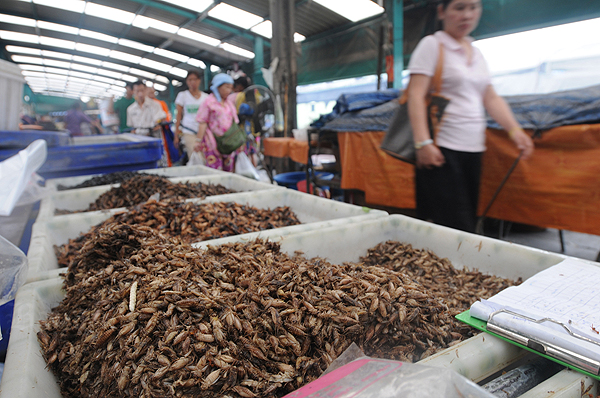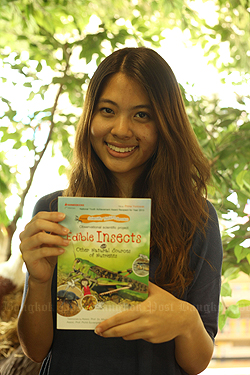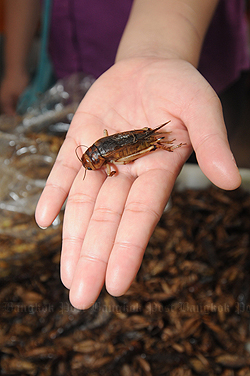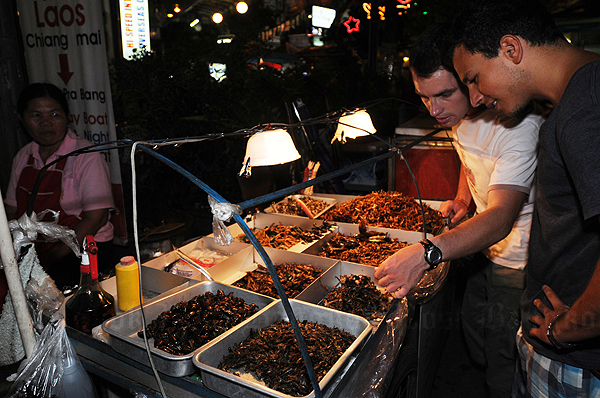
By Ajarn Helen Jandamit
Photos courtesy of Bangkok Post
University Tips is here to help you prepare for the English exams and tests that are coming your way. It gives you practise answering questions similar to those you may have at school and also on the University Entrance Examination.
Read the following story by Pattramon Sukprasert from the Bangkok Post. Then, answer the questions that follow.
With a published book and a future at Stanford University, 18-year-old junior researcher Prima Yontrarak is well on her way to success.
BUG BOOK
If you’re hungry, grab a bug, says Prima Yontrarak. Her journey to become a researcher has begun with the publication of her first book, based on her studies of the benefits of eating insects.
Last year, Nanmeebooks, a local publishing house, found out about her bug research and asked if they could publish it. Edible Insects and Other Natural Sources of Nutrients has been published in Thai and in English-language versions.
Prima's book focuses on the nutritional value of edible bugs, as well as their life cycles and cultivation. "The human population keeps increasing. Eating insects is a solution that can probably tackle the issue of food scarcity as they are widely available in many countries,” explains Prima, a 12th-grade student at Harrow International School.
She adds that insects are rich in protein and low in fat. Cicadas and locusts contain a larger proportion of proteins and fibre than meat.

HEALTHY CREATURES
Prima’s interest in doing research on edible bugs started years ago when she took part in school community service activities. She wondered why some children remained healthy although they came from poor families. "So I interviewed them and they said they often ate insects.”
Prima’s teachers encouraged her to seek solutions or answers as well as ask questions, so she began to study edible insects and conduct a field study too.
“I worked with local people, asking them to send me samples of the insects they ate. Sometimes I went to the Northeast to collect them myself. The samples were sent to Mahidol University to be analysed.” Her research took two years.
“If people keep consuming insects in an unsustainable way, at one point some insects might become extinct, so breeding could be a solution,” she says.
BRIGHT FUTURE
Prima has taken an internship at the National Science and Technology Development Agency. She will leave high school this year, and has already been accepted by Stanford University in the US, where she will further her education in biology.
Since 2010, Prima and her friends have been running their own community service organisation, Lionheart Society. Some of the Lionheart Society's projects include supporting poor rural schools financially and teaching low-income students in Bangkok.
Exercises
Section 1
Read the story and answer the following multiple-choice questions.
1. Which book did Prima write?
a. Natural Sources of Nutrients.
b. Edible Bugs and Their Sources of Nutrients.
c. Edible Insects and Other Natural Sources of Nutrients.
2. Who has published Prima’s book?
a. Stanford University.
b. Nanmeebooks.
c. The Lionheart Society.
3. When did Prima first become interested in edible insects?
a. When she took part in school community service activities.
b. When she interviewed some healthy children.
c. When she left high school.
4. Where did Prima’s field study take place?
a. At the National Science and Technology Development Agency.
b. In the Northeast.
c. At Harrow International School.
5. Where were her field study samples sent to be analysed?
a. Stanford University
b. Mahidol University
c. The National Science and Technology Development Agency.
6. How much protein do cicadas and locusts contain?
a. They contain a larger proportion of proteins and fibre than meat.
b. They contain a smaller proportion of proteins and fibre than meat.
c. They contain the same amount of proteins and fibre as meat.
7. Why is Prima interested in breeding insects?
a. Because they are widely available in many countries.
b. Because they might become extinct if too many are eaten.
c. Because they can probably tackle the issue of food scarcity.
8. How long did Prima’s research into edible insects take?
a. Two years.
b. From 2010 until now.
c. 18 years.
Section 2
Read the story and decide whether the following statements are true or false.
9. Prima is 18 years old.
………………………
10. Prima’s book was published last year.
………………………
11. Stanford University is located in England.
………………………
12. The Lionheart Society is a government agency.
………………………
Section 3
Fill in the blanks in the following passage with the correct words from the choices given.
“I believe that university is the time for exploration. …..13….. experimentation,” says Prima. “But for now I see myself as …..14….. researcher on healthcare and agriculture, as I aim to improve …..15….. country. If we can innovate and develop our …..16….. products, we won't have to rely …..17….. imports, and prices of …..18….. would be cheaper.”

13.
a. with
b. and
c. but
14.
a. the
b. an
c. a
15.
a. me
b. mine
c. my
16.
a. own
b. owning
c. owner
17.
a. on
b. in
c. for
18.
a. good
b. goods
c. goodies
Section 4
Find vocabulary words in the story that are synonyms of the following words.
19. rising ……………….
20. started ……………….
21. consumed ……………….

Section 5
Find vocabulary words in the story that are antonyms of the following words.
22. rich ……………….
23. inedible ……………….
24. rejected ……………….
Vocabulary
- nutritional (adj): he process by which living things receive the food necessary for them to grow and be healthy
cultivation (n): the preparation and use of land for growing plants or crops
scarcity (n): a situation where there is not enough of something
fibre (n): the part of food that helps to keep a person healthy by keeping the bowels working and moving other food quickly through the body
extinct (adj): no longer in existence


